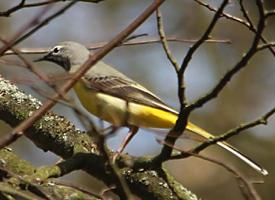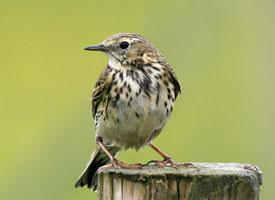
Descrierea animalului
The European Rock Pipit, scientifically known as Anthus petrosus, is a small, charismatic bird belonging to the pipit family. It is a species that exhibits fascinating adaptations to its coastal habitat, making it a subject of interest for birdwatchers and ornithologists alike. This bird is primarily found along the rocky coastlines of western and northern Europe, including the British Isles, Norway, and as far south as Portugal. It thrives in environments that many other species might find inhospitable, from the spray-soaked cliffs to the stony, seaweed-strewn beaches that characterize its preferred habitats.Measuring approximately 16-17.5 cm in length, with a wingspan of 25-28 cm, the European Rock Pipit is a bird of modest size but significant presence. Its plumage is a study in subtlety, with varying shades of brown, gray, and olive, providing excellent camouflage against the rocky shores and vegetation of its natural habitat. The bird's underparts are a lighter, often streaked appearance, which helps in blending with the surroundings, especially during the breeding season.
The diet of the European Rock Pipit consists mainly of small invertebrates, including insects and their larvae, small crustaceans, and occasionally seeds. This diet reflects the bird's adaptability and its role in the coastal ecosystem as a forager of the intertidal zones.
One of the most distinguishing features of the European Rock Pipit is its song. The male's vocal performance, particularly during the breeding season, is a melodic and intricate display, consisting of a series of sweet trills and chirps. This song serves not only to attract mates but also to mark territory, a crucial aspect of their breeding ecology.
Breeding typically takes place from April to July. The European Rock Pipit is a ground nester, with females laying clutches of 4-6 eggs in a well-concealed nest among the rocks or dense vegetation. Both parents are involved in the care of the young, which fledge approximately two weeks after hatching. This period is a critical time for the fledglings, as they learn to navigate the complexities of their environment under the watchful eyes of their parents.
Migration patterns of the European Rock Pipit vary; while some populations are resident, others migrate southward to escape the harshest winter conditions. These migrations, though not long-distance in comparison to other avian species, are significant for the survival of certain populations, especially those breeding in the far north of their range.
Conservation-wise, the European Rock Pipit is considered of Least Concern by the International Union for Conservation of Nature (IUCN), thanks to its wide distribution and relatively stable population numbers. However, like many coastal species, it faces threats from habitat destruction, pollution, and the broader impacts of climate change, which could affect its food sources and breeding sites.
In summary, the European Rock Pipit is a remarkable bird, emblematic of the rugged, natural beauty of Europe's coastal landscapes. Its life cycle, from the intricately constructed nests to the melodious songs of the males, reflects a fascinating adaptation to its environment. As such, it continues to captivate those who are lucky enough to observe it in its natural habitat, serving as a reminder of the intricate connections within our world's ecosystems.
Animale similare
Fotografii noi cu animale
Top 10 animale
- Dolphin gull (Leucophaeus scoresbii)
- Diana monkey (Cercopithecus diana)
- Galápagos tortoise (Geochelone nigra complex)
- Moustached guenon (Cercopithecus cephus)
- Japanese spider crab (Macrocheira kaempferi)
- Colossal squid (Mesonychoteuthis hamiltoni)
- Stone loach (Barbatula barbatula)
- Fox tapeworm (Echinococcus multilocularis)
- Japanese macaque (Macaca fuscata)
- Barbary macaque (Macaca sylvanus)


